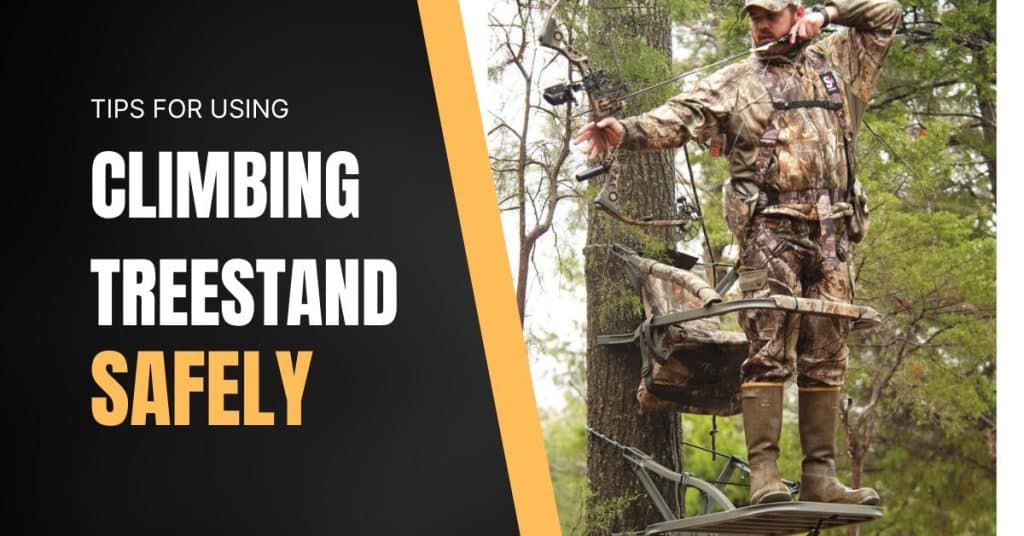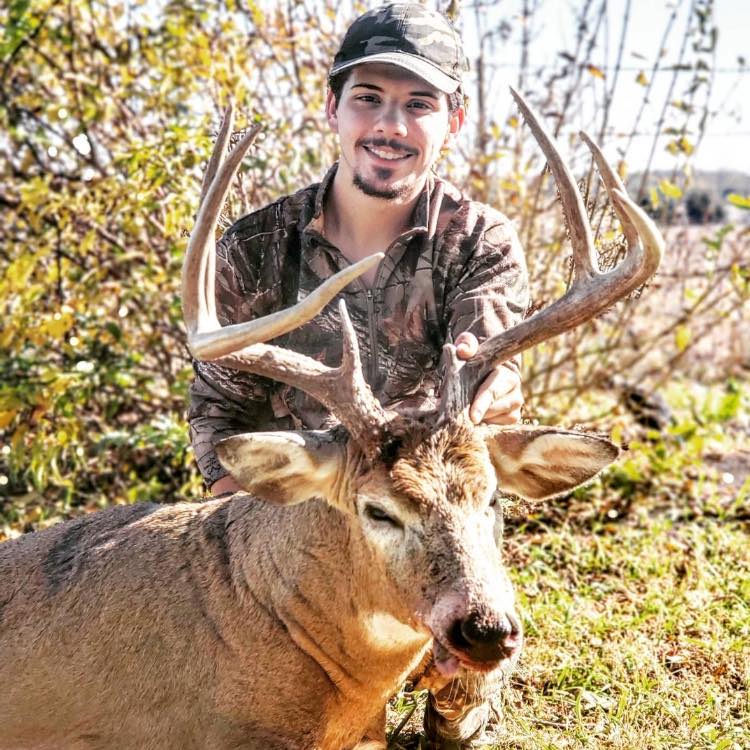Hunting accidents are a serious concern for treestand hunters. Statistics reveal that approximately one in three or one in four hunters will experience an accident during their hunting career. It is crucial to prioritize safety while using climbing tree stands. In this article, we will provide some simple yet effective tips to keep you safe when climbing tree stands.
Tips for Using Climbing Tree Stands

Wear Safety Gear
One of the most essential safety measures after selecting the right treestand for hunting is wearing a safety vest or harness. This basic safety gear is worth its weight in gold, as it ensures your protection. The full-body safety treestand harness consists of shoulder straps, leg straps, and a tether. If you were to fall from the tree stand, the harness would prevent you from hitting the ground by suspending you in mid-air. Investing in a quality safety vest is a wise choice to safeguard your well-being.
Choosing the Right Tree for Your Climbing Tree Stand
Before heading out on your hunting adventure, it’s essential to carefully select the appropriate tree for your climbing tree stand. The tree you choose can greatly impact your hunting experience, so consider the following factors.
- Look for a straight tree with no branches that could impede your climbing process. This will ensure a smooth ascent to your desired height.
- Become familiar with the trees in your hunting area to make an informed decision. Certain trees, such as Ironwood, possess hard bark that may pose challenges for the teeth of your tree stand to securely grip onto. It is advisable to avoid these trees to minimize the risk of slipping.
To pick the right tree for setting up your treestand, follow these guidelines:
Once you have located an ideal hunting spot, the next step is to identify a suitable tree to set up your treestand. Consider the following factors when making your selection:
- Opt for mature trees with thick trunks. Mature trees provide fuller cover, offering better concealment during your hunting endeavors.
- Younger trees tend to sway more in the wind, which can be hazardous. Therefore, it is advisable to choose mature trees for added stability and safety.
- Some recommended options for stable limbs to set up your treestand include oak woods, cedars, and cottonwood. These mature trees offer secure branches, allowing you to position your treestand at heights ranging from 20 to 25 feet above the ground.
- Additionally, ensure that the chosen tree provides sufficient cover. The presence of ample cover will aid in your concealment while hunting. Consider using a treestand featuring camouflage to further enhance your hiding capabilities.
By carefully considering these factors, you can select the right tree for your climbing tree stand and maximize your hunting success.
Level Your Platform
Additionally, when setting up your climbing tree stand, ensure that the platform is level. With experience, you will learn the optimal positioning required to achieve a balanced platform. Adjust the bottom of the stand against the tree trunk to achieve the desired level. Avoid extreme tilting in either direction, as leaning too far forward can cause you to fall off the front, while excessive backward tilt may disengage the teeth, compromising your safety. Maintaining a level platform enhances your balance while hunting, even at heights of 20 to 25 feet, offering stability and reducing the chances of accidents.
Secure Two-Piece Stands: Connection for Safety
If you have a two-piece climbing tree stand, such as the Summit Tighten model, securing the top and bottom pieces is essential. To ensure your safety, connect the tether to prevent the platform from dropping out of reach in case of an unexpected event. A simple knot can effectively secure the two pieces and maintain stability while climbing.
Consider Platform Size: Space and Stability
Consider the size of the tree stands platform when making your selection. A wider and larger platform offers several advantages, especially if you are taller or heavier. It provides more space and stability, which can be beneficial if you experience vertigo or have issues with heights. The fear of heights can affect your balance, and a larger platform reduces the risk of losing your footing.
Additional Tips For Staying Safe when Using a Treestand
Treestand-related injuries are becoming common. Thus it is important to know how to keep yourself safe.
- Be careful with your gear such as the compound bow or rifle weight distribution. Do not put all your gear on one side of the treestand. This can cause a weight imbalance, which in turn causes the treestand to sway dangerously.
- Also, be keen on the weather. Knowing the forecast is important, but preparing for weather changes is more important. When it’s raining, take extra care when climbing into or out of your treestand.
- Also, if you are using a ladder treestand, always maintain a three-point contact area to avoid falling off.
The Climbing Process Using Climbing Tree Stand: Step-by-Step Guide
Now let’s go through the process of setting up and climbing a tree using a climbing tree stand. Once you leave the ground, it is crucial to remain connected to the tree at all times. As you enter the stand, ensure you are securely attached to the tree at ground level. This connection is maintained throughout your climbing process, ensuring your safety. Set your feet in the stirrups, adjust your hand climber, and then fasten your safety tether around the tree trunk. This tether prevents any significant falls and secures your position.
Climbing Up
To ascend the tree, stand on the hand portion of the stand while maintaining your connection to the tree with the safety tether. Take the necessary time and care to climb steadily and securely. Although climbing silently and quickly might be tempting, safety should always be prioritized over speed. Remember, a little extra time and effort can prevent potential accidents.
Setting Up at the Desired Height: Ensuring Comfort
Once you reach your desired height, it’s time to set up your tree stand accordingly. Adjust the seat strap to secure your seat in place, ensuring it remains stable throughout your hunting session. This positioning will help determine the ideal placement of your tether above you. By setting the tether in the seated position, you minimize the distance you would fall in case of a slip, preventing jarring impacts and ensuring your safety.
Climbing Down: A Safe Descent
When descending from the tree, follow the same process but in reverse. Gradually lower your belt while keeping the tether connected to both sections of the stand. This continuous connection ensures that the tree stand remains within reach at all times, providing an added layer of safety. Take your time when climbing up or down, ensuring you maintain your balance at all times. Losing balance is the leading cause of falls and accidents. By practicing caution and maintaining balance, you significantly reduce the risk of mishaps.
Tips for a Successful Hunting Experience Using a Treestand
Hunting can be an exhilarating and rewarding outdoor activity, and using a treestand can significantly enhance your chances of success. A treestand provides hunters with an elevated vantage point, enabling better visibility and minimizing human scent detection. However, maximizing your hunting experience using a treestand requires careful planning and execution. In this article, we will discuss several essential tips that will help you achieve a successful hunting experience using a treestand.
Choose the Right Treestand:
Selecting the appropriate treestand is crucial to ensure comfort and safety during your hunting expedition. There are various types of treestands available, including ladder stands, climbing stands, and hang-on stands. Consider factors such as tree suitability, ease of installation, weight capacity, and personal preference before making a purchase. Always prioritize safety features like a secure harness system and sturdy construction.
Scout Your Hunting Location:
Before setting up your treestand, spend ample time scouting the area to identify the best hunting spots. Look for signs of animal activity, such as tracks, rubs, or droppings. Locate food sources, water bodies, and natural funnels that animals may use for travel. Understanding the terrain and animal behavior will help you choose the ideal location to position your treestand.
Concealment and Scent Control:
When hunting from a treestand, concealment is paramount. Ensure that your treestand blends seamlessly with the surrounding environment by using natural camouflage or adding brush and foliage. Additionally, practice scent control techniques to minimize your human odor. Wash your hunting clothes with scent-free detergents, store them in scent-proof bags, and use scent-eliminating sprays to mask your odor.
Set up in Advance:
To avoid unnecessary noise and disturbance on the day of your hunt, it’s advisable to set up your treestand well in advance. Install your treestand at least a few weeks before hunting season begins, allowing animals to acclimate to its presence. This will reduce the chances of spooking wildlife and increase your chances of a successful hunt.
Safety First:
Always prioritize safety when using a treestand. Carefully read and follow the manufacturer’s instructions for installation and usage. Utilize a reliable safety harness system and wear it at all times while in the treestand. Regularly inspect your treestand for any signs of wear or damage, and replace worn-out parts as necessary. Remember, safety should never be compromised.
Practice Shot Placement:
Hunting from an elevated position can impact shot placement. It is crucial to understand the anatomy of your target animal and practice shooting from an elevated position before the hunting season. Familiarize yourself with the appropriate shooting angles to ensure clean and ethical kills.
Maintain Stealth and Patience:
When hunting from a treestand, maintaining stealth and exercising patience are essential. Make minimal movements and avoid unnecessary noise that could alert nearby game. Stay alert, as animals may approach your treestand without notice. Patience is key; be prepared to wait for extended periods, as animals may take time to come into range.
Mask Your Scent
While a treestand can make it harder for deer to detect your scent, animals have a superb sense of smell. Use a scent blocker to minimize your scent and gain an advantage over your prey.
Avoid Noise
A deer’s ears are just as good as their nose. Therefore, it is crucial to avoid making noise while you are up in the treestand. Stay focused and alert to any movement you make, minimizing the chances of alarming nearby deer.
Remember, even when you are up in a tree, it does not mean you are impossible to detect. A deer can still smell you or hear any noise you make. Taking precautions will increase your chances of a successful hunt.
Conclusion
By following these safety tips and guidelines, you can have a safer and more successful hunting experience with your climbing tree stand. Remember to prioritize your safety by wearing a safety harness, choosing the right tree, maintaining a stable platform, and practicing caution throughout the climbing process. Enjoy the advantages of a treestand while ensuring the well-being of yourself and others.

About The Author:
Lake Streeter, A Gun enthusiast, and loves to hunt in the middle of the wood. Always check the latest hunting gears out in the market and try to share his honest opinion with the audience in Hunting Nook.
